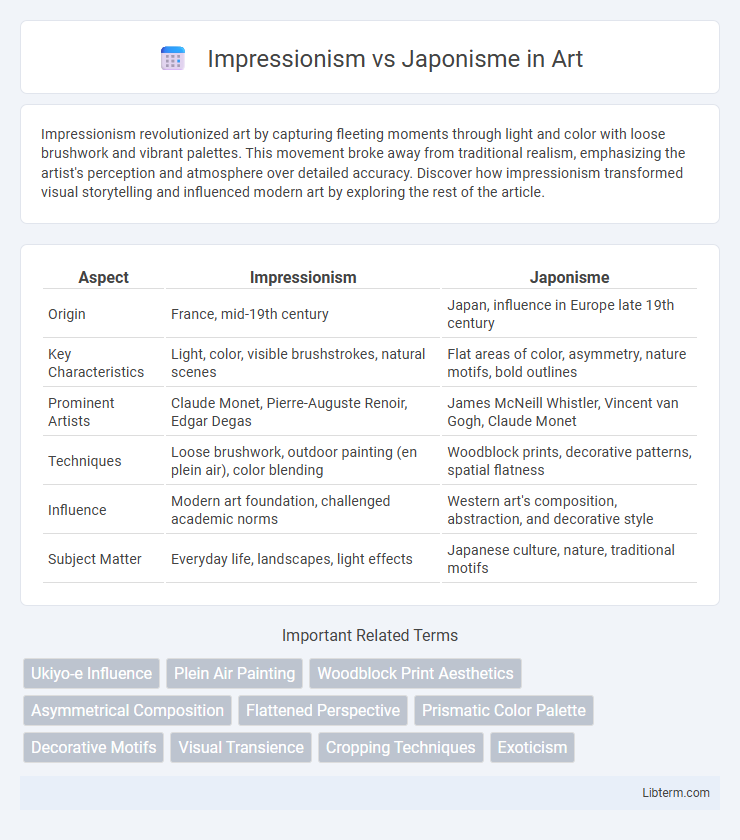Impressionism revolutionized art by capturing fleeting moments through light and color with loose brushwork and vibrant palettes. This movement broke away from traditional realism, emphasizing the artist's perception and atmosphere over detailed accuracy. Discover how impressionism transformed visual storytelling and influenced modern art by exploring the rest of the article.
Table of Comparison
| Aspect | Impressionism | Japonisme |
|---|---|---|
| Origin | France, mid-19th century | Japan, influence in Europe late 19th century |
| Key Characteristics | Light, color, visible brushstrokes, natural scenes | Flat areas of color, asymmetry, nature motifs, bold outlines |
| Prominent Artists | Claude Monet, Pierre-Auguste Renoir, Edgar Degas | James McNeill Whistler, Vincent van Gogh, Claude Monet |
| Techniques | Loose brushwork, outdoor painting (en plein air), color blending | Woodblock prints, decorative patterns, spatial flatness |
| Influence | Modern art foundation, challenged academic norms | Western art's composition, abstraction, and decorative style |
| Subject Matter | Everyday life, landscapes, light effects | Japanese culture, nature, traditional motifs |
Introduction: Defining Impressionism and Japonisme
Impressionism, a 19th-century art movement originating in France, emphasizes light, color, and spontaneous brushwork to capture fleeting moments in everyday life. Japonisme refers to the European fascination and influence of Japanese art and aesthetics following Japan's opening to the West in the mid-1800s, characterized by bold compositions, flat color planes, and nature motifs. The intersection of Impressionism and Japonisme significantly shaped modern art, as artists like Claude Monet and Edgar Degas incorporated Japanese techniques and themes into their Impressionist works.
Historical Context and Emergence
Impressionism emerged in the late 19th century as a French art movement characterized by rapid brushstrokes and an emphasis on light and natural scenes, reacting against traditional academic painting. Japonisme refers to the influence of Japanese art and aesthetics on Western art, beginning after Japan's trade reopening in the 1850s, profoundly impacting Impressionist artists like Monet and Degas. The historical context of industrialization and international trade expansion facilitated the cross-cultural exchange that shaped the evolution of both movements.
Key Influences and Inspirations
Impressionism was deeply influenced by the fleeting effects of light and color in everyday scenes, drawing inspiration from plein air painting and the use of loose brushwork to capture momentary impressions. Japonisme introduced Western artists to Japanese woodblock prints, emphasizing flat planes, bold outlines, and unconventional compositions, which challenged traditional Western perspectives. The fusion of Impressionist techniques with Japanese aesthetics created a unique artistic dialogue that transformed modern art.
Artistic Techniques and Styles
Impressionism emphasizes rapid brushstrokes, vibrant light effects, and capturing fleeting moments, creating a sense of spontaneity and movement. Japonisme introduces flat color planes, asymmetrical compositions, and bold outlines inspired by Japanese ukiyo-e prints, influencing Western artists to explore new perspectives and stylistic simplifications. The fusion of techniques led to a hybrid style where Impressionists incorporated Japanese aesthetics, enhancing their experimentation with form and color harmony.
Color Palettes and Brushwork
Impressionism is characterized by vibrant, light-infused color palettes with loose, quick brushwork that captures fleeting moments and atmospheric effects. Japonisme draws inspiration from traditional Japanese art, featuring flat, bold colors and precise, defined outlines with more decorative and stylized brushstrokes. Both movements altered Western art by emphasizing color and brushwork but differed in approach: Impressionism prioritized natural light and spontaneity, while Japonisme emphasized compositional balance and graphic simplicity.
Major Artists and Their Contributions
Impressionism, led by major artists like Claude Monet, Edgar Degas, and Pierre-Auguste Renoir, revolutionized painting through vibrant light effects and spontaneous brushwork, emphasizing everyday scenes and natural landscapes. Japonisme influenced artists such as Vincent van Gogh, James McNeill Whistler, and Mary Cassatt, integrating Japanese aesthetics like flat planes, asymmetry, and bold outlines into Western art, enriching its compositional techniques. Both movements contributed significantly to modern art by blending distinct visual languages, with Impressionism focusing on perception and atmosphere, while Japonisme introduced new perspectives and decorative elements.
Iconic Artworks Comparison
Impressionism, epitomized by Claude Monet's "Water Lilies," emphasizes light and color through loose brushwork and fleeting moments, while Japonisme, influenced by Japanese ukiyo-e prints like Hokusai's "The Great Wave off Kanagawa," features bold lines, flat color areas, and asymmetrical compositions. Monet's use of natural light contrasts with the stylized patterns and flattened perspective prominent in Japonisme, as seen in works by artists such as James McNeill Whistler. The fusion of these styles in pieces like Vincent van Gogh's "Flowering Plum Tree" illustrates the interplay between Western Impressionist techniques and Eastern aesthetic principles.
Cultural Exchange Between East and West
Impressionism, characterized by its emphasis on light and movement, was deeply influenced by Japonisme, the European fascination with Japanese art and aesthetics following Japan's opening to the West in the mid-19th century. This cultural exchange introduced Western artists like Claude Monet and Edgar Degas to Japanese woodblock prints, which inspired new approaches to composition, perspective, and color. The fusion of Eastern techniques and Western innovation fostered a transformative period in art, highlighting the dynamic interplay between East Asian traditions and European modernism.
Impact on Modern Art Movements
Impressionism revolutionized modern art with its emphasis on light, color, and spontaneous brushwork, inspiring subsequent movements like Post-Impressionism and Fauvism. Japonisme introduced Western artists to Japanese aesthetics, including flat compositions and bold outlines, profoundly influencing Art Nouveau and Cubism. Both movements challenged traditional European art conventions, fostering experimentation that propelled the evolution of 20th-century modern art.
Lasting Legacy and Contemporary Relevance
Impressionism's lasting legacy is evident in its revolutionary use of light and color that transformed modern art and influenced countless contemporary artists worldwide. Japonisme introduced Western art to Japanese aesthetics, such as flat perspectives and bold compositions, which continue to inspire design, fashion, and visual arts today. Both movements underscore the importance of cross-cultural exchange in the evolution of global art trends and modern creative practices.
Impressionism Infographic

 libterm.com
libterm.com